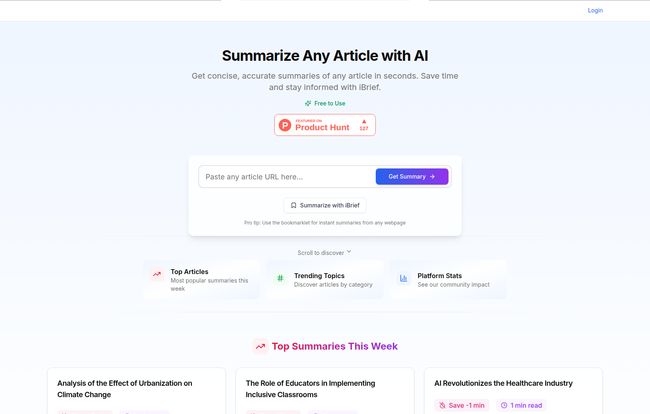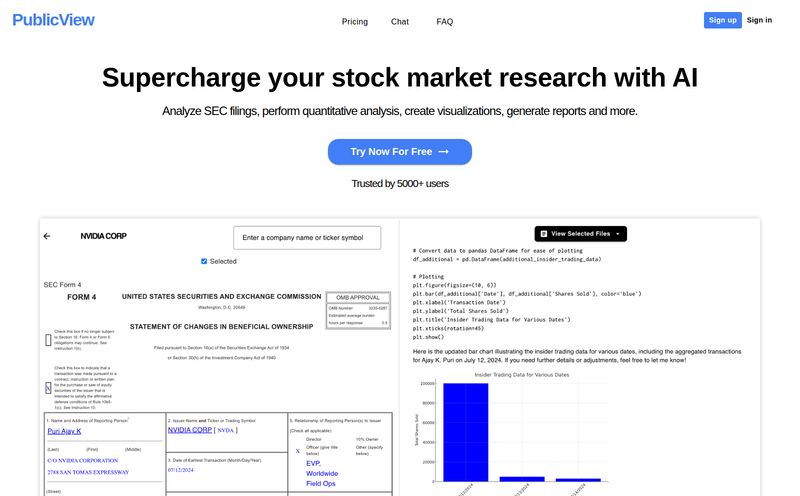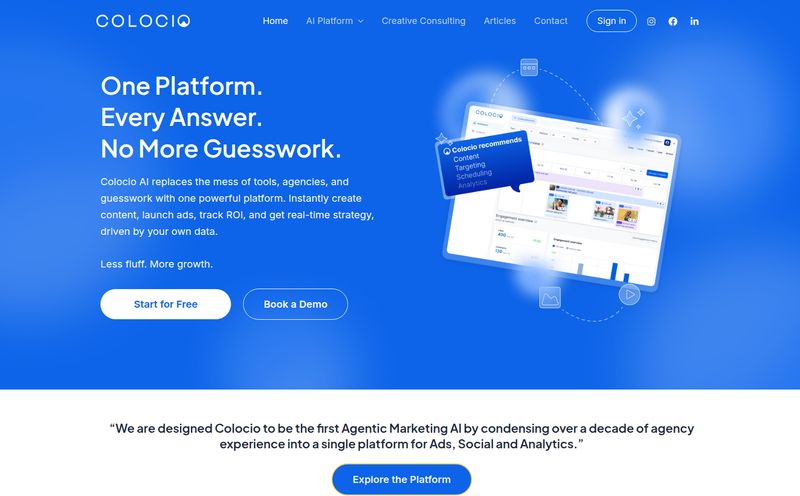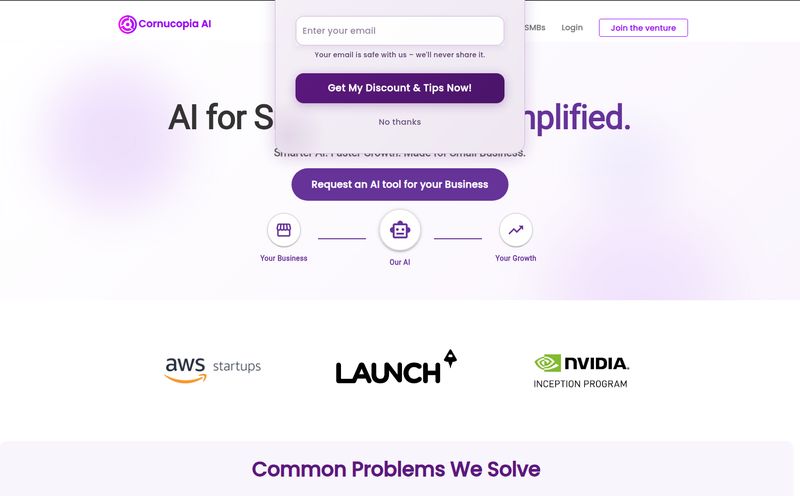My browser currently has 37 tabs open. And that's just in this one window. There's that deep-dive on the latest Google algorithm update, a fascinating (but long) article about programmatic SEO, a few trend reports, and a recipe for sourdough that I will absolutely, positively never make. Sound familiar? We're all drowning in a sea of content, armed with the best intentions and the worst attention spans.
For years, the promise of AI has dangled the ultimate carrot in front of us: what if a robot could just... read all this for you? I’ve tried a bunch of AI summarizer tools. Some were clunky, some were hidden behind a paywall after three uses, and some gave me summaries so generic they were completely useless. So, when I stumbled upon iBrief, my expectations were, let's say, managed. But I have to admit, I'm pleasantly surprised.
So, What’s the Deal with iBrief?
At its core, iBrief is a free-to-use AI tool designed to do one thing: read any online article and spit out a concise, scannable summary. You feed it a URL, and its AI gets to work, pulling out the main points so you can absorb the gist in about a minute. The homepage is clean, no-nonsense, and proudly wears its Product Hunt badge of honor, which is always a good sign in my book.
It’s not trying to be your all-in-one AI assistant. It’s not trying to write your emails or generate images of cats in space. It's a focused tool for a very specific, and very common, problem: too much to read, too little time.
Putting It to the Test: My First Impressions
Getting started is about as simple as it gets. You've got two main ways to do the magic.
The Classic Copy-Paste
The most straightforward method is right on the homepage. You find an article you want to understand, copy the URL, paste it into the box, and hit “Get Summary.” Within seconds, you have a summary. It's simple, it's effective, and it works exactly as you'd expect. No complaints here.

Visit iBrief
The Bookmarklet Is the Real MVP
Now, this is where iBrief really won me over. They offer a “Summarize with iBrief” bookmarklet. If you’re not familiar, a bookmarklet is like a tiny app that lives in your browser’s bookmark bar. My bookmark bar is a chaotic wasteland of forgotten tools and links, but I made space for this one. Why?
Because you don’t have to leave the page you’re on. You’re reading an article, you realize it's a 20-minute commitment you don't have, and you just click the bookmarklet. A neat little summary pops up. It's seamless. It's the difference between having to walk to the kitchen to get a snack versus having a snack appear in your hand. One is a chore; the other feels like a superpower. This feature alone makes it an essentail part of my daily workflow now.
The Good, The Bad, and The AI-Generated
No tool is perfect, especially in the wild west of AI. So let's have some real talk about where iBrief shines and where you should be a little cautious.
What I Genuinely Love About iBrief
First and foremost, the time saved is legit. I tested it on a few dense industry reports. An article that was a solid 15-minute read got condensed into key points I could digest in about 60 seconds. This is huge for triaging content. Is this article worth my full attention? The iBrief summary tells me almost instantly.
Second, the price. It's free. Not “free for a 7-day trial” or “free for 3 summaries a month.” Just… free. In a world of endless subscriptions, a genuinely useful and free tool feels like finding a unicorn.
I also kind of dig the ‘Trending Topics’ and ‘Top Summaries’ sections on the homepage. It’s a nice, passive way to see what others are reading and get a quick pulse on important topics in tech, business, and society without falling into a social media rabbit hole.
Where It Gets a Little... Murky
Okay, let's not get carried away. The summary quality is entirely dependent on the AI. For a straightforward news article, it's brilliant. For a deeply nuanced opinion piece or a technical paper filled with jargon? It can sometimes miss the subtlety. The summary will give you the facts, but it might strip away the author's unique voice or a critical underlying argument.
And then there's the ever-present elephant in the AI room: bias. All AI models are trained on vast datasets from the internet, and as we all know, the internet isn't exactly a bastion of pure, unbiased thought. The way an AI chooses to summarize something can be influenced by the biases in its training data. It's something to be aware of with any AI tool, not just iBrief. A summary should always be a starting point, not the absolute gospel.
It’s a cheat sheet for the internet, not a replacement for critical thinking.
Who Should Add iBrief to Their Toolkit?
I can see a few groups of people getting a ton of value out of this:
- Students and Researchers: Imagine plowing through a dozen academic papers to find the three that are actually relevant to your thesis. iBrief could be a massive time-saver for literature reviews.
- Busy Professionals: If you're a marketer, developer, or exec, you need to stay on top of industry news. This lets you scan 20 headlines and articles in the time it would take to read two.
- Content Curators & Social Media Managers: Need to find interesting articles to share? This is a great way to quickly vet content before sharing it with your audience.
- The Casually Curious: Anyone who just wants to be more informed without dedicating their entire lunch break to reading one article.
How iBrief Fits into the Crowded AI Space
There are other summarizers out there, sure. Many are part of larger, paid AI suites that promise to do everything. But I think iBrief's strength is its simplicity. It knows exactly what it is—a fast, free, and efficient article summarizer. It’s not bloated with features I'll never use. It's a specialized tool that does its one job exceptionally well, and the bookmarklet integration makes it more practical for day-to-day use than many of its competitors.
The community stats on the homepage, showing how many articles have been processed and how much time has been collectively saved, also add a nice touch. It feels less like a corporate product and more like a shared utility built for people who are passionate about knowledge, but short on time.
My Final Verdict
So, is iBrief the magic bullet for information overload? No, of course not. That would be too easy. You still lose important context, authorial tone, and the sheer pleasure of a well-written piece. It's a trade-off.
But as a first line of defense? A tool to help you decide where to invest your precious attention? It's one of the best I've found. It's fast, the bookmarklet is brilliant, and it's free. For me, it has earned its permanent, coveted spot on my chaotic bookmark bar. If your tabs look anything like mine, I'd say it's definitely worth a shot.
Frequently Asked Questions
- Is iBrief really free to use?
- Yes, based on all the information on their site, iBrief is completely free to use. There are no pricing pages or subscription models mentioned.
- How does the iBrief bookmarklet work?
- You simply drag the bookmarklet from the iBrief homepage to your browser's bookmark bar. Then, when you're on any article page, you just click it, and it will generate a summary without you having to leave the page.
- Can I trust the AI summaries 100%?
- I wouldn't. While the summaries are generally accurate for getting the main idea, they are generated by an AI. They can miss nuance, and there's a potential for AI bias. It's best to use them as a tool for screening content, and then read the full article for anything truly important.
- What kind of articles can iBrief summarize?
- It's designed to summarize pretty much any public article on the web. It works best with standard news articles, blog posts, and reports. It might struggle with PDFs, paywalled content, or very unusual website formats.
- How do I share a summary I've created?
- The platform has built-in sharing capabilities. Once a summary is generated, you should see options to share the concise version with others, which is great for teams or sharing on social media.
Reference and Sources
- iBrief Official Website
- iBrief on Product Hunt
- MIT Technology Review: This is how AI bias really happens



